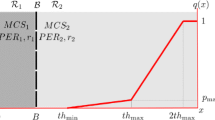Abstract
This paper analyses an alternative traffic queuing model for the quality of service (QoS) optimization in mobile communications systems. According to the proposed model, the queue of handover attempts is separated to each of the used transceivers of a base transceiver station that covers a particular area. Fixed channel assignment and TDMA are considered, while the proposed technique is compared to the classic queuing model. The comparison results show that the QoS of the proposed model is fully optimized, especially if large queue sizes are chosen.
Similar content being viewed by others
References
N.R. Sollenberger, N. Seshardi and R. Cox, “The Evolution of IS-136 TDMA for 3rd Generation Wireless Services”, IEEE Personal Communications, June 1999, pp. 8–18.
A. Furuskar, S. Mazur, F. Müller and H. Olofsson, “Enhanced Data Rates for GSM and TDMA/136 Evolution”, IEEE Personal Communications, June 1999, pp. 56–66.
D. Hong and S.S. Rappaport, “Traffic Model and Performance Analysis for Cellular Mobile Radio Telephone Systems with Prioritized and Non Prioritized Handover Procedures,” IEEE Transactions on Vehicular Technology, Vol. 35, 1986, 77–92.
C.J. Chang, T.T. Su and Y.Y. Chiang, “Analysis of a Cutoff Priority Cellular Radio System with Finite Queueing and Reneging/Dropping”, IEEE/ACM Transactions on Networking, Vol. 2, 1994, 166–174.
R. Guerin, “Queuing-Blocking System with two Arrival Stream and Guard Channels”, IEEE Transactions on Communications, Vol. 36, 1988, 153–163.
R. Ramjee, R. Nagarajan and D. Towsley, “On Optimal Call Admission Control in Cellular Networks,” University of Massachusetts Technical Report UM-CS-1995-064, 1995.
I. Panoutsopoulos, S. Kotsopoulos, K. Ioannou and S. Louvros, “Priority Technique for Optimizing the Handover Procedure in Personal Communication Systems”, Electronics Letters, Vol. 36, No. 7, 2000, 669–670.
P. Tran-Gia and M. Mandjes, “Modelling of Customer Retrial Phenomenon in Cellular Mobile Networks”, University of Wurzburg, Institute of Computer Science, Research Report No. 142, 1996, 1–19.
E. Del Re, R. Fantacci and G. Giambene, “Handover Queuing Strategies with Dynamic and Fixed Channel Allocation Techniques in Low Earth Orbit Mobile Satellite Systems”, IEEE Transactions on Communications, Vol. 47, No. 1, 1999, 89–102.
H. Takagi, K. Sakamaki and T. Miyashiro, “Call Loss and Forced Termination Probabilities in Cellular Radio Communication Networks with Non-Uniform Traffic Conditions”, IEICE Transactions on Communications, Vol. E82-B, No. 9, 1999, 1496–1504.
Author information
Authors and Affiliations
Corresponding author
Rights and permissions
About this article
Cite this article
Panoutsopoulos, I., Kotsopoulos, S., Ioannou, K. et al. An Alternative Queuing Technique to Optimize the Performance of TDMA Based Mobile Communication Systems. Wireless Pers Commun 31, 149–159 (2004). https://doi.org/10.1007/s11277-004-1641-8
Issue Date:
DOI: https://doi.org/10.1007/s11277-004-1641-8




